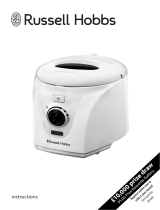
5
7. Using the oven glove, hold the basket by the handle and lower the basket slowly and gently into the oil.
8. The oil will foam as it comes into contact with water from the food. As long as the foam
doesn’t threaten to overow the bowl, this should not be a cause for alarm.
9. If the foam threatens to overow the bowl, remove the basket, set it back on the kitchen
paper, then see the “problems” section.
10. Wait till the food has cooked.
11. Check it’s cooked. If you’re in doubt, cook it a bit more.
12. Using the oven glove, lift the basket by the handle.
13. Empty the food into the colander, to drain further before serving.
14. Return the empty basket to the rim of the bowl.
15. If you want to cook another batch of food, check the oil level and top up as necessary.
16. Once nished, unplug the appliance.
HINTS AND TIPS
• Adding food to the oil reduces the temperature of the oil.
• If you add a little food, the temperature will recover quickly, and the food will be cooked
properly.
• When you put food into the appliance, you should see bubbles given o.
• This is steam, formed when the moisture inside the food heats up.
• The steam coming out of the food prevents oil from soaking into the food.
• The food cooks uniformly – rm and crisp.
• If you add too much food, the temperature will not recover, and your food will absorb oil.
COATINGS AND BATTERS
Coat all foods, except those high in starch, like potatoes and doughnuts. The coating protects
the food, helps prevent juices leaking into the oil, and gives a crisp tasty result. Generally,
coatings won’t stick to frozen foods.
Seasoned our
Thicker coatings don’t stick well to wet/damp foods, so coat them rst in seasoned our. Use on
its own to coat small whole oily sh like whitebait.
Egg and breadcrumbs
Popular on sh, chicken, and scotch eggs, it gives an attractive, crisp, crunchy exterior. Ideal for
foods that are to be served cold, as it stays crisp for hours.
1. Coat in seasoned our, to dry the food. Dip in beaten egg, then breadcrumbs, repeat till
fully coated, press well, then shake o any excess.
2. Fresh breadcrumbs give a rough appearance. Make dry breadcrumbs or raspings by baking
scraps of bread till golden, then crush or process to a ne crumb.
Basic batter
• 100g self raising our
• 1 pinch salt
• water
Sift the our into a bowl. Add the salt. Just before it’s needed, stir in enough water to form a
smooth batter.


















